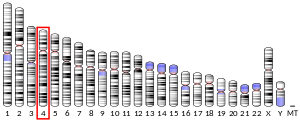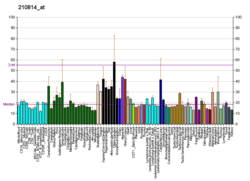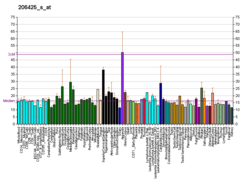TRPC3
Short transient receptor potential channel 3 (TrpC3) also known as transient receptor protein 3 (TRP-3) is a protein that in humans is encoded by the TRPC3 gene. The TRPC3/6/7 subfamily are implicated in the regulation of vascular tone, cell growth, proliferation and pathological hypertrophy.[5] These are diacylgylcerol-sensitive cation channels known regulate intracellular calcium via activation of the phospholipase C (PLC) pathway and/or by sensing Ca2+ store depletion.[6] Together, their role in calcium homeostasis has made them potential therapeutic targets for a variety of central and peripheral pathologies.[7]
Function
Non-specific cation conductance elicited by the activation of TrkB by BDNF is TRPC3-dependent in the CNS.[8] TRPC channels are almost always co-localized with mGluR1-expressing cells and likely play a role in mGluR-mediated EPSPs.[9]
The TRPC3 channel has been shown to be preferentially expressed in non-excitable cell types, such as oligodendrocytes.[6] However, evidence suggests that active TRPC3 channels in basal ganglia (BG) output neurons are responsible for maintaining a tonic inward depolarizing current that regulates resting membrane potential and promotes regular neuronal firing.[10] Conversely, inhibiting TRPC3 promotes cellular hyperpolarization, which can lead to slower and more irregular neuronal firing. While it's unclear if TRPC3 channels have equal expression, other members of the TRPC family have been localized to the axon hillock, cell body, and dendritic processes of dopamine-expressing cells.[11]
The neuromodulator, substance P, activates TRPC3/7 channels inducing cellular currents that underlie rhythmic pacemaker activity in the brainstem, enhancing the regularity and frequency of respiratory rhythms,[12] showing homology to the mechanism described in BG neurons. Transgenic cardiomyocytes expressing TRPC3 show prolonged action potential duration when exposed to a TRPC3 agonist.[13] The same cardiomyocytes also increase their firing rate with agonist exposure under a current-clamp tetanus protocol suggesting that they may play a role in cardiac arrhythmogenesis.
Modulators
A small molecule agonist is GSK1702934A and antagonists are GSK417651A and GSK2293017A.[5] A commercially available inhibitor is available in the form of a pyrazole compound, Pyr3[14] TRPC3 has been shown to specifically interact with TRPC1[15][16] and TRPC6.[17]
See also
References
- GRCh38: Ensembl release 89: ENSG00000138741 - Ensembl, May 2017
- GRCm38: Ensembl release 89: ENSMUSG00000027716 - Ensembl, May 2017
- "Human PubMed Reference:". National Center for Biotechnology Information, U.S. National Library of Medicine.
- "Mouse PubMed Reference:". National Center for Biotechnology Information, U.S. National Library of Medicine.
- Xu X, Lozinskaya I, Costell M, Lin Z, Ball JA, Bernard R, Behm DJ, Marino JP, Schnackenberg CG (2013-01-29). "Characterization of Small Molecule TRPC3 and TRPC6 agonist and Antagonists". Biophysical Journal. 104 (2, Supplement 1): 454a. doi:10.1016/j.bpj.2012.11.2513.
- Fusco FR, Martorana A, Giampà C, De March Z, Vacca F, Tozzi A, Longone P, Piccirilli S, Paolucci S, Sancesario G, Mercuri NB, Bernardi G (July 2004). "Cellular localization of TRPC3 channel in rat brain: preferential distribution to oligodendrocytes". Neuroscience Letters. 365 (2): 137–42. doi:10.1016/j.neulet.2004.04.070. PMID 15245795.
- Kaneko Y, Szallasi A (2013-01-01). "TRP channels as therapeutic targets". Current Topics in Medicinal Chemistry. 13 (3): 241–3. doi:10.2174/1568026611313030001. PMID 23432057.
- Li HS, Xu XZ, Montell C (1999). "Activation of a TRPC3-dependent cation current through the neurotrophin BDNF". Neuron. 24 (1): 261–73. doi:10.1016/S0896-6273(00)80838-7. PMID 10677043.
- Giampà C, DeMarch Z, Patassini S, Bernardi G, Fusco FR (September 2007). "Immunohistochemical localization of TRPC6 in the rat substantia nigra". Neuroscience Letters. 424 (3): 170–4. doi:10.1016/j.neulet.2007.07.049. PMID 17723267.
- Zhou FW, Matta SG, Zhou FM (January 2008). "Constitutively active TRPC3 channels regulate basal ganglia output neurons". The Journal of Neuroscience. 28 (2): 473–82. doi:10.1523/JNEUROSCI.3978-07.2008. PMC 3652281. PMID 18184790.
- Zhu MX, Huang J, Du W, Yao H, Wang Y (2011). Zhu MX (ed.). TRPC Channels in Neuronal Surviva. Boca Raton (FL): CRC Press/Taylor & Francis. ISBN 978-1-4398-1860-2. PMID 22593969.
- Ben-Mabrouk F, Tryba AK (April 2010). "Substance P modulation of TRPC3/7 channels improves respiratory rhythm regularity and ICAN-dependent pacemaker activity". The European Journal of Neuroscience. 31 (7): 1219–32. doi:10.1111/j.1460-9568.2010.07156.x. PMC 3036165. PMID 20345918.
- Doleschal B, Primessnig U, Wölkart G, Wolf S, Schernthaner M, Lichtenegger M, Glasnov TN, Kappe CO, Mayer B, Antoons G, Heinzel F, Poteser M, Groschner K (April 2015). "TRPC3 contributes to regulation of cardiac contractility and arrhythmogenesis by dynamic interaction with NCX1". Cardiovascular Research. 106 (1): 163–73. doi:10.1093/cvr/cvv022. PMC 4362401. PMID 25631581.
- Kiyonaka S, Kato K, Nishida M, Mio K, Numaga T, Sawaguchi Y, Yoshida T, Wakamori M, Mori E, Numata T, Ishii M, Takemoto H, Ojida A, Watanabe K, Uemura A, Kurose H, Morii T, Kobayashi T, Sato Y, Sato C, Hamachi I, Mori Y (March 2009). "Selective and direct inhibition of TRPC3 channels underlies biological activities of a pyrazole compound". Proceedings of the National Academy of Sciences of the United States of America. 106 (13): 5400–5. doi:10.1073/pnas.0808793106. PMC 2664023. PMID 19289841.
- Strübing C, Krapivinsky G, Krapivinsky L, Clapham DE (October 2003). "Formation of novel TRPC channels by complex subunit interactions in embryonic brain". The Journal of Biological Chemistry. 278 (40): 39014–9. doi:10.1074/jbc.M306705200. PMID 12857742.
- Xu XZ, Li HS, Guggino WB, Montell C (June 1997). "Coassembly of TRP and TRPL produces a distinct store-operated conductance". Cell. 89 (7): 1155–64. doi:10.1016/S0092-8674(00)80302-5. PMID 9215637.
- Hofmann T, Schaefer M, Schultz G, Gudermann T (May 2002). "Subunit composition of mammalian transient receptor potential channels in living cells". Proceedings of the National Academy of Sciences of the United States of America. 99 (11): 7461–6. doi:10.1073/pnas.102596199. PMC 124253. PMID 12032305.
Further reading
- Islam, Md. Shahidul (January 2011). Transient Receptor Potential Channels. Advances in Experimental Medicine and Biology. 704. Berlin: Springer. p. 700. ISBN 978-94-007-0264-6.
- Lemmon MA (March 2005). "Pleckstrin homology domains: two halves make a hole?". Cell. 120 (5): 574–6. doi:10.1016/j.cell.2005.02.023. PMID 15766521.
- Clapham DE, Julius D, Montell C, Schultz G (2006). "International Union of Pharmacology. XLIX. Nomenclature and structure-function relationships of transient receptor potential channels". Pharmacol. Rev. 57 (4): 427–50. doi:10.1124/pr.57.4.6. PMID 16382100.
- Eder P, Poteser M, Groschner K (2007). TRPC3: A Multifunctional, Pore-Forming Signalling Molecule. Handbook of Experimental Pharmacology. 179. pp. 77–92. doi:10.1007/978-3-540-34891-7_4. ISBN 978-3-540-34889-4. PMID 17217051.
- Ben-Mabrouk F, Tryba AK (April 2010). "Substance P modulation of TRPC3/7 channels improves respiratory rhythm regularity and ICAN-dependent pacemaker activity". The European Journal of Neuroscience. 31 (7): 1219–32. doi:10.1111/j.1460-9568.2010.07156.x. PMC 3036165. PMID 20345918.
External links
- TRPC3+protein,+human at the US National Library of Medicine Medical Subject Headings (MeSH)
This article incorporates text from the United States National Library of Medicine, which is in the public domain.





